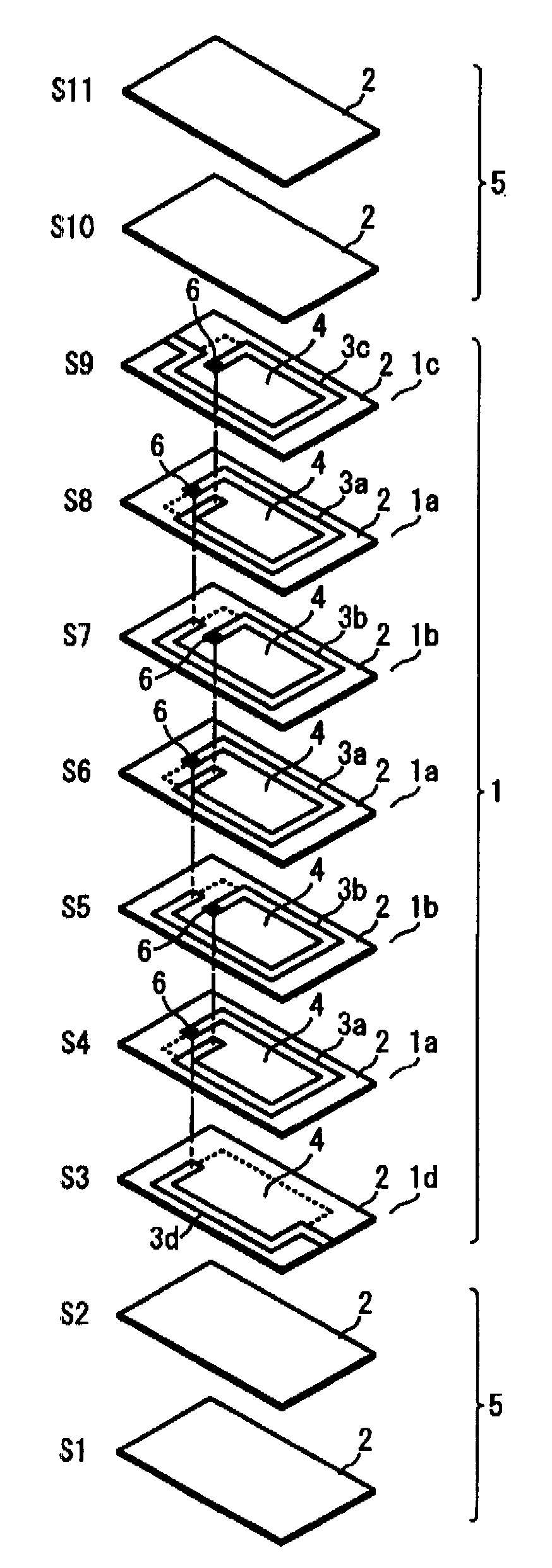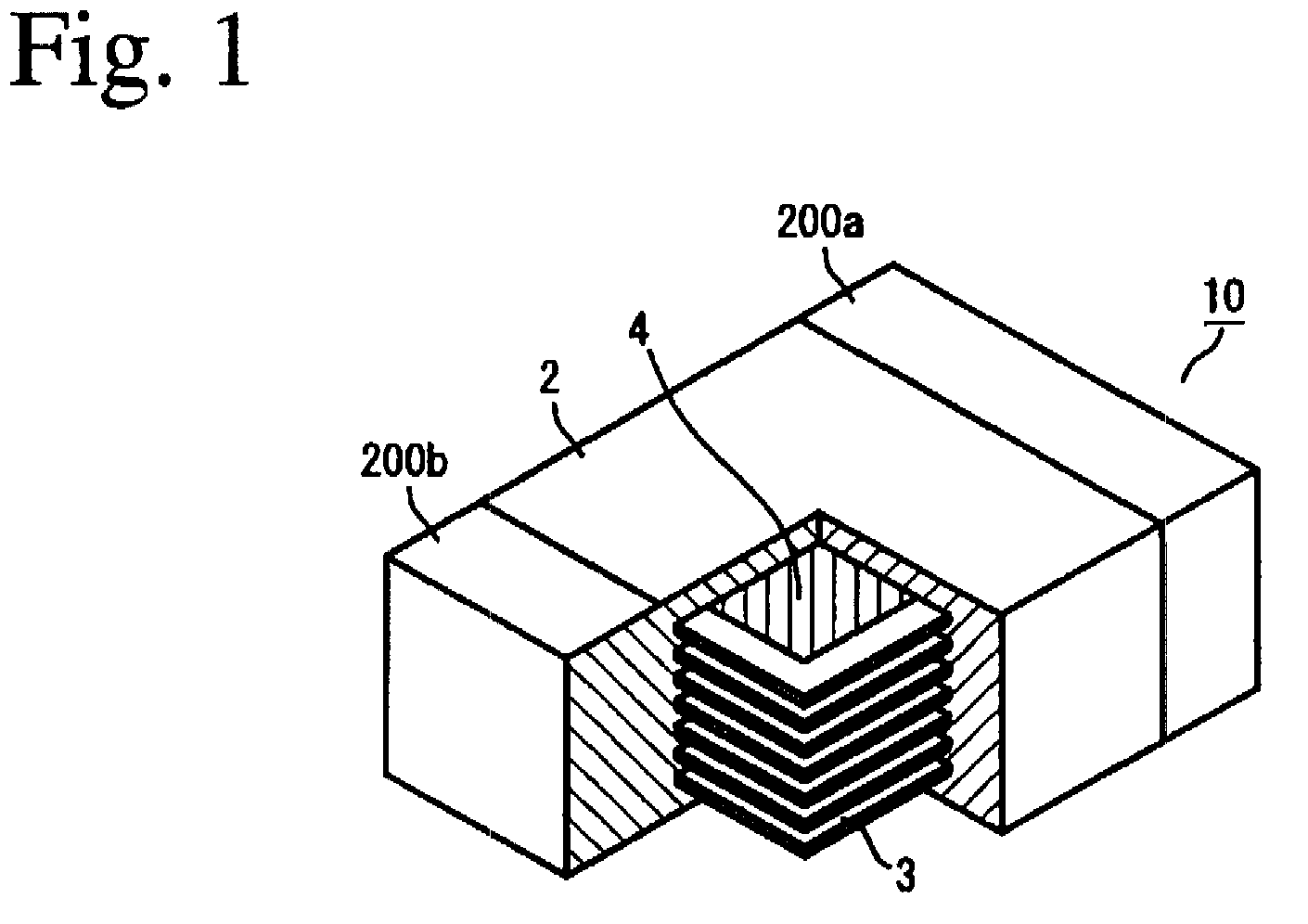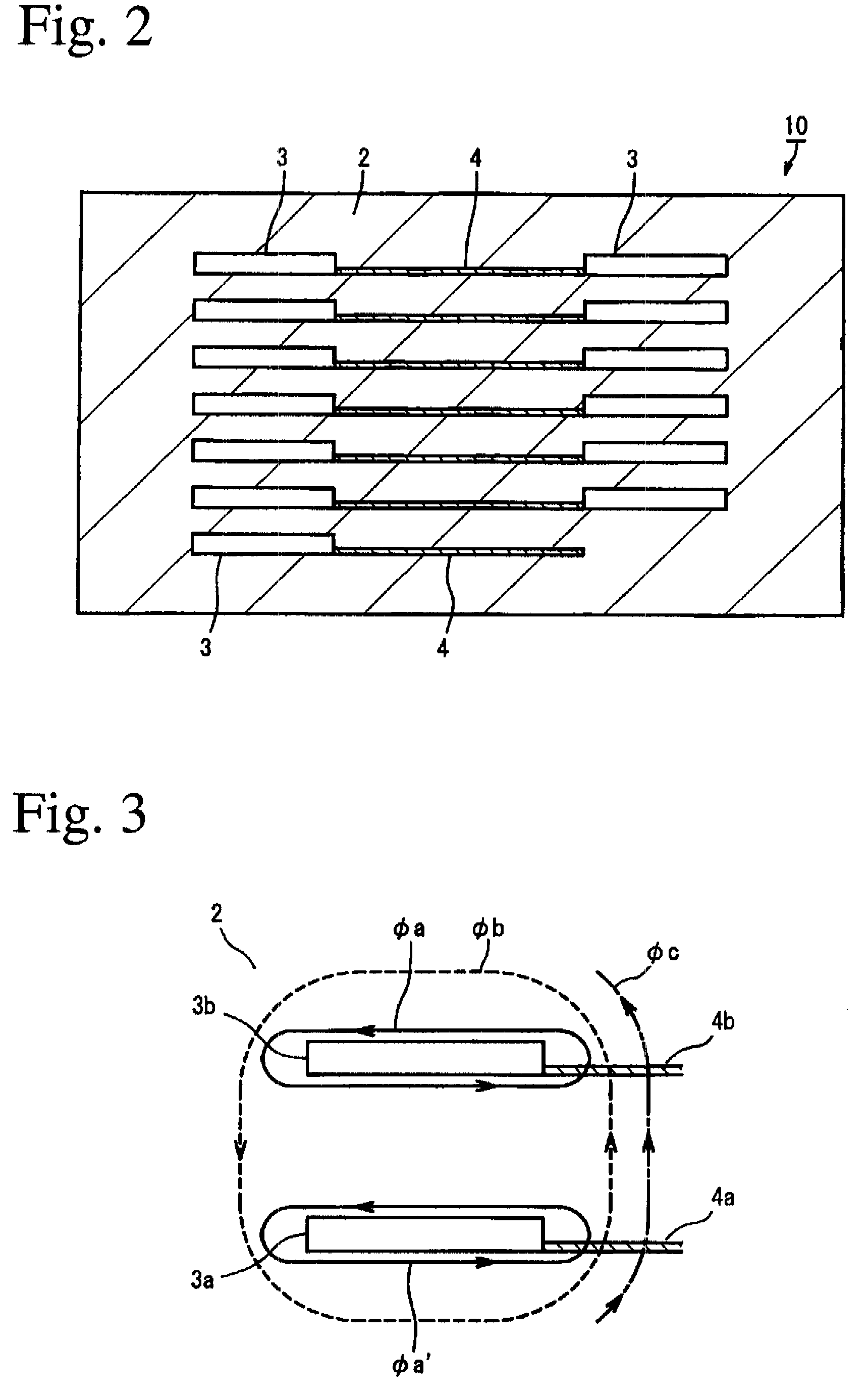Laminate device and module comprising same
a laminated inductors and magnetic circuit technology, applied in the direction of inductances, inductances with magnetic cores, cores/yokes, etc., can solve the problems of poor dc-superimposed characteristics of laminated inductors, drastic decreases in inductance, and limited miniaturization of laminated inductors, etc., to achieve stable inductance, excellent dc-superimposed characteristics, and easy production
- Summary
- Abstract
- Description
- Claims
- Application Information
AI Technical Summary
Benefits of technology
Problems solved by technology
Method used
Image
Examples
example 1
(1) Production of First Laminate Device Shown in FIGS. 1 to 6 (Sample A of Example)
[0124]100 parts by weight of calcined Ni—Cu—Zn ferrite powder (Curie temperature Tc: 240° C., and initial permeability at a frequency of 100 kHz: 300) comprising 49.0% by mol of Fe2O3, 13.0% by mol of CuO, and 21.0% by mol of ZnO, the balance being NiO, was blended with 10 parts by weight of an organic binder based on polyvinyl butyral, a plasticizer and a solvent by a ball mill, to form a magnetic material slurry, which was formed into green sheets.
[0125]Some of the green sheets were provided with through-holes 6, and the green sheets having through-holes 6 and those without through-holes were printed with a non-magnetic zirconia paste for forming magnetic gap layers 4 in a predetermined pattern, and then printed with a conductive Ag paste for forming coil patterns 3.
[0126]To remove a step between the printed zirconia paste layer and the printed Ag paste layer, an imprinted region was printed with a ...
example 2
(1) Production of First Laminate Device Shown in FIGS. 7 and 8 (Sample 4 of Example)
[0131]A laminate device (laminated inductor, Sample 4) of 3.2 mm×1.6 mm and 1.0 mm in thickness having 7-μm-thick magnetic gap layers formed on all of 16 coil-pattern-carrying layers was produced in the same manner as in Example 1, except for using calcined Li—Mn—Zn ferrite powder (Curie temperature Tc: 250° C., and initial permeability at a frequency of 100 kHz: 300) comprising 3.8% by mass of Li2CO3, 7.8% by mass of Mn3O4, 17.6% by mass of ZnO, 69.8% by mass of Fe2O3, and 1.0% by mass of Bi2O3, in place of the calcined Ni—Cu—Zn ferrite powder. To be free from a step, each coil-pattern-carrying layer was printed with a Ni—Zn ferrite paste in a region in which the zirconia paste and the Ag paste were not printed. After sintering, the magnetic substrate layer had a thickness of 40 μm, the coil pattern had a thickness of 20 μm and a width of 300 μm, and a region inside the coil pattern was 2.2 mm×0.6 m...
example 3
Production of Fourth Laminate Device Shown in FIGS. 13 and 14 (Sample 5)
[0137]A laminated inductor (Sample 5) was produced in the same manner as in Sample 4, except that a Li—Mn—Zn ferrite layer was formed in a rectangular opening 14 of 0.3 mm×0.3 mm provided in a region including the center axis of a coil in the magnetic gap layer. The laminated inductor of Sample 5 was measured with respect to DC-superimposed characteristics and DC-DC conversion efficiency. The results are shown in Table 2 and FIG. 42.
[0138]
TABLE 2Number of TurnsNumber ofNumber ofThickness (μm)Total Gapof Coil PatternCoil-Pattern-Magneticof MagneticLengthSampleon Each LayerCarrying LayersGap LayersGap Layer(μm)41161671125116167112Ferrite-Filled Layer inInductance (μH) WithDC-DC ConversionSampleMagnetic Gap LayerNo Current LoadEfficiency (%)4No3.977.55Formed in all layers10.278.6
[0139]The laminated inductor of this Example (Sample 5) exhibited larger inductance than the second laminate device (Sample 4) at low DC c...
PUM
| Property | Measurement | Unit |
|---|---|---|
| switching frequency | aaaaa | aaaaa |
| temperature | aaaaa | aaaaa |
| thickness | aaaaa | aaaaa |
Abstract
Description
Claims
Application Information
 Login to View More
Login to View More - R&D
- Intellectual Property
- Life Sciences
- Materials
- Tech Scout
- Unparalleled Data Quality
- Higher Quality Content
- 60% Fewer Hallucinations
Browse by: Latest US Patents, China's latest patents, Technical Efficacy Thesaurus, Application Domain, Technology Topic, Popular Technical Reports.
© 2025 PatSnap. All rights reserved.Legal|Privacy policy|Modern Slavery Act Transparency Statement|Sitemap|About US| Contact US: help@patsnap.com



